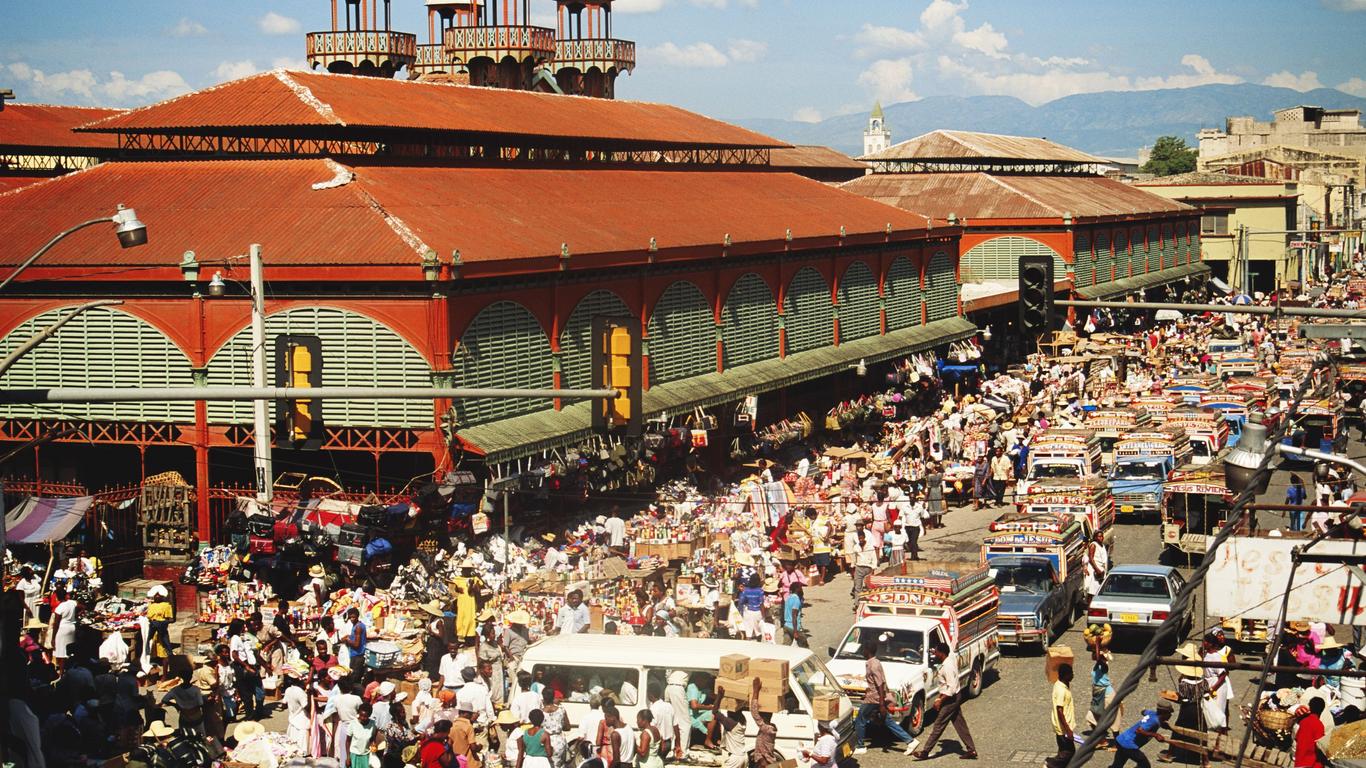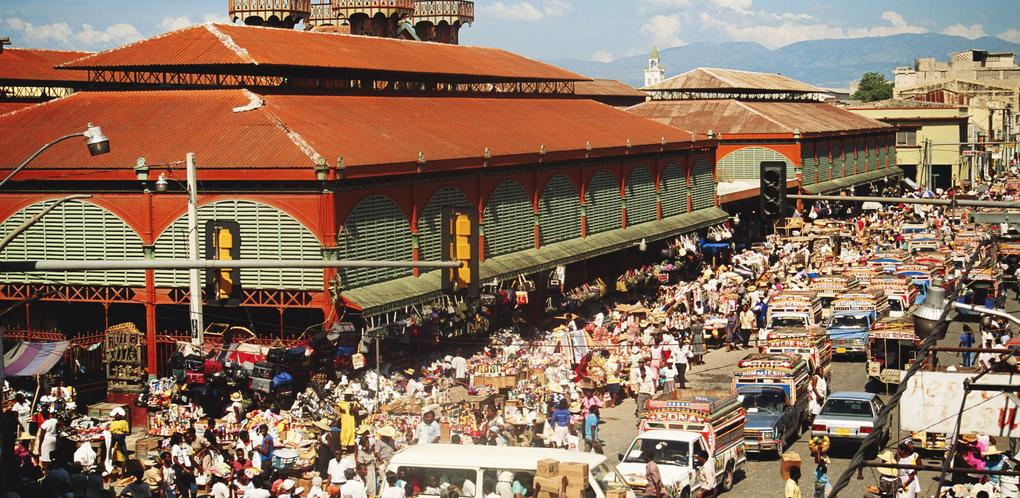
Port Au Prince travel guide
Port Au Prince Tourism | Port Au Prince Guide
You're Going to Love Port Au Prince
Haiti's capital Port-au-Prince attracts thousands of visitors every year, with its beautiful tropical landscape, colorful buildings, and voodoo culture.

Top 5 Reasons to Visit Port Au Prince
1. Marché de Fer
This flea market attracts hundreds of shoppers as they bargain over artwork, iron work, voodoo beaded flags, and dolls.
2. Musée du Panthéon National Haïtien
Learn about Haitian revolutionaries and get an in-depth look at local cultural traditions at this popular Port-au-Prince museum.
3. Étang Saumâtre
Visit the largest lake in Haiti just outside of the city center right along the border of the Dominican Republic.
4. Barbancourt Rum Distillery
Take a tour of the distillery and learn about the history of rum in Haiti (while sampling some of the local products).
5. Fort Jacques
This National Park nestled in a pine forest offers great views of Haiti from up in the mountains, just a 45-minute drive outside of the city.
What to do in Port Au Prince
1. Musée du Panthéon National Haïtien: Hidden Treasures Underground
The exterior of the Musée du Panthéon National Haïtien is deceiving -- an abstract sculpture garden with an ornamental pool in the middle of downtown Port Au Prince. It's underground, where you will find one of the largest collections of historic artifacts in the Caribbean. Highlights include an impressive 13-foot tall anchor from the famous Santa Maria, Columbus' flagship which landed on Haiti's northern coast. Other treasures include the crowns of Haiti's former kings and emperors and the silver gun used by King Henri Christophe to commit suicide in 1820.
2. Palais National: The White House of Haiti
The ruins of this graceful structure, that once served as the official residence of Haiti's president, stand in the middle of Champs de Mars. Designed by Haitian architect Georges H. Baussan in 1912, it's an excellent example of neo-Classical style, including Ionic columns and three domes. Plans were announced in April 2017 for reconstruction. Near the Champ de Mars and currently also in ruins, the Cathédrale de Port-au-Prince -- also called the Cathédrale Notre-Dame de Port-au-Prince -- is also awaiting reconstruction.
3. Port-au-Prince Cathedral: Lively Iron Market
The ornate, bright-red Iron Market or Marché de Fer has been at the heart of life in Port Au Prince since it was built in 1889. The striking structure houses a busy public market that is popular with locals and tourists alike. Inside, the south hall is lined with food stalls offering a wide range of choices. The north hall is a giant artisan craft market, with locally produced arts and crafts for sale. The Middle Eastern theme of the building comes from its original purpose -- it was built to become a railway station in Cairo, Egypt. Nowadays, no one is sure exactly how it came to be in Haiti's capital city.
4. Fort Jacques: City Fortifications
There are panoramic views of the city to be seen from the hillside perch of Fort Jacques. Built shortly after Haiti's independence in 1804, the stone fort overlooks the city and harbor. There are grounds to explore along with the structures and cannons that are pointed towards the waterfront, and the ruins of Fort Alexandre are a short distance away. Fort Jacques is about 2 miles from the city and accessible by foot or rented motor scooter.
5. Champs de Mars: A Gathering Place
This large square in the center of the city is where to find the Musée du Panthéon National and the former Palais National along with a busy scene of sidewalk cafés and street vendors offering bargain purchases. It sits at the convergence of several parks and the city's major boulevards. It's ringed by trees and includes the imposing equestrian statue of Henri Christophe. It's a popular spot with locals and visitors alike to enjoy a drink in the afternoon or evening.
1. Musée du Panthéon National Haïtien: Hidden Treasures Underground
The exterior of the Musée du Panthéon National Haïtien is deceiving -- an abstract sculpture garden with an ornamental pool in the middle of downtown Port Au Prince. It's underground, where you will find one of the largest collections of historic artifacts in the Caribbean. Highlights include an impressive 13-foot tall anchor from the famous Santa Maria, Columbus' flagship which landed on Haiti's northern coast. Other treasures include the crowns of Haiti's former kings and emperors and the silver gun used by King Henri Christophe to commit suicide in 1820.
2. Palais National: The White House of Haiti
The ruins of this graceful structure, that once served as the official residence of Haiti's president, stand in the middle of Champs de Mars. Designed by Haitian architect Georges H. Baussan in 1912, it's an excellent example of neo-Classical style, including Ionic columns and three domes. Plans were announced in April 2017 for reconstruction. Near the Champ de Mars and currently also in ruins, the Cathédrale de Port-au-Prince -- also called the Cathédrale Notre-Dame de Port-au-Prince -- is also awaiting reconstruction.
3. Port-au-Prince Cathedral: Lively Iron Market
The ornate, bright-red Iron Market or Marché de Fer has been at the heart of life in Port Au Prince since it was built in 1889. The striking structure houses a busy public market that is popular with locals and tourists alike. Inside, the south hall is lined with food stalls offering a wide range of choices. The north hall is a giant artisan craft market, with locally produced arts and crafts for sale. The Middle Eastern theme of the building comes from its original purpose -- it was built to become a railway station in Cairo, Egypt. Nowadays, no one is sure exactly how it came to be in Haiti's capital city.
4. Fort Jacques: City Fortifications
There are panoramic views of the city to be seen from the hillside perch of Fort Jacques. Built shortly after Haiti's independence in 1804, the stone fort overlooks the city and harbor. There are grounds to explore along with the structures and cannons that are pointed towards the waterfront, and the ruins of Fort Alexandre are a short distance away. Fort Jacques is about 2 miles from the city and accessible by foot or rented motor scooter.
5. Champs de Mars: A Gathering Place
This large square in the center of the city is where to find the Musée du Panthéon National and the former Palais National along with a busy scene of sidewalk cafés and street vendors offering bargain purchases. It sits at the convergence of several parks and the city's major boulevards. It's ringed by trees and includes the imposing equestrian statue of Henri Christophe. It's a popular spot with locals and visitors alike to enjoy a drink in the afternoon or evening.
Where to Eat in Port Au Prince
Coin Vert serves homemade Haitian food, including a selection of lamb, meat, and chicken dishes served alongside cold, locally brewed beer. A typical meal costs 300 HTG.
When to visit Port Au Prince
The best time to visit is between December and March, when there is little rainfall and the weather is less humid.
How to Get to Port Au Prince
Plane
Hugo Chávez International Airport (CAP) and Toussaint Louverture International Airport (PAP) are the two main entry points for most visitors, located in the north and west respectively. To reach get into town, you can take a tap tap or a minibus costing anywhere from 10-1,000 HTG depending on how you negotiate with the driver.
Car
Take route 46 from Santo Domingo, Dominican Republic to arrive in Port-au-Prince in just under six hours.
Bus
Caribe Tours, Capital Coach Line, and Terra Bus offer buses from other points in Haiti and to international spots in the Dominican Republic. One-way tickets with border fees cost around 4,100 HTG.
Airlines serving Port Au Prince
Where to stay in Port Au Prince
Pétionville - this wealthy neighborhood is located in the hills to the east and is known for its plethora of expats, bars, and restaurants.
Popular Neighborhoods in Port-au-Prince
Champs de Mars - this green area attracts many visitors, who can walk among gardens and view some of the ruins left in the wake of the 2010 earthquake.
Croix-des-Bouquets - this region in the west is popular for being home to many local artists and markets selling their work.
Where to stay in popular areas of Port Au Prince
How to Get Around Port Au Prince
Public Transportation
Tap taps, or shared taxis, are brightly colored buses, and are the most common way of traveling around the capital. A standard fare costs 10 HTG and will get you to most places in the city.
Taxi
Taxi fares start at 30 HTG. Rides within Port-au-Prince generally cost 500 HTG. Visitors should avoid taking these at night when fares are higher and it is more dangerous.
Car
There are many rental vehicles available for pick up at the airport, or several downtown locations. Daily rental prices start at 2,000 HTG.
The Cost of Living in Port Au Prince
Shopping Streets
Marché de Fer and Village Artistique de Noailles are the two main open air markets. Delmas 2000 is a more traditional shopping store selling toys, appliances, and home decor.
Groceries and Other
Giant Supermarket and Caribbean Supermarket are the two main grocery stores. A dozen eggs costs 230 HTG.
